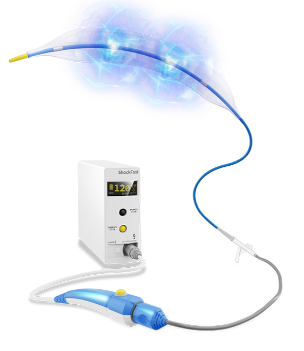Intravascular Lithotripsy: What You Need to Know
When balloon angioplasty fails to alter calcified plaque, intravascular lithotripsy (IVL) is helpful regarding the treatment for coronary artery calcification. IVL breaks superficial and deep calcium using acoustic pressure waves, keeping vascular integrity and improving stent compliance. The targeted method also lessens tissue damage, dissection, and perforation risk. So, the process optimizes luminal gain in calcified arteries for better coronary and peripheral IVL procedures.

What is Intravascular Lithotripsy?
Intravascular lithotripsy uses balloon catheters to administer sonic pressure waves to treat calcified coronary and peripheral artery disease. Pressure waves break calcium deposits intimal and medial that resist percutaneous treatments. As a result, it heightens vascular compliance for stent placement. Due to its targeted disruption of calcified tissue rather than soft tissue, IVL targets calcium without artery dissection or perforation. For example, studies suggest IVL delivers adequate lumen expansion without high-pressure balloon inflations to avoid barotrauma risk.
How Does Intravascular Lithotripsy Work?
Intravascular lithotripsy fractures calcified deposits in artery walls using acoustic pressure waves to prevent soft tissue harm. IVL generator, connector cable, and catheter make up the system. The catheter with emitters is introduced into the artery and placed at the calcified location. The generator transfers electrical impulses via the connecting cable to the catheter, which generates high-energy pulsatile sound waves. Acoustic waves create vessel fluid microcavitation bubbles.
When these bubbles burst, energy spreads through the vessel, cracks, and breaks calcium. IVL decreases artery dissection and perforation with lower pressures than high-pressure balloons or atherectomy. E.g., 10 IVL catheter pulses may shatter deep, concentric calcium for arterial extension in stiff calcified lesions that may have restricted stent delivery or balloon angioplasty success[1]. IVL promotes regulated and predictable dilatation in calcified coronary and peripheral arteries while disrupting superficial and deep calcium without affecting arterial compliance.
When to Use Intravascular Lithotripsy?
The following are the diseases for which intravascular lithotripsy is currently used in treatment:
- Coronary artery disease (CAD).
- Severe coronary artery calcification.
- Peripheral artery disease (PAD).
- Atherosclerotic plaque calcification.
- Calcified coronary artery lesions.
- Calcified peripheral artery lesions.
- Renal artery stenosis.
- Iliac artery stenosis.
- Femoral artery stenosis.
- Popliteal artery stenosis.
- Tibial artery stenosis.
- Superficial femoral artery (SFA) stenosis.
- Abdominal aortic aneurysm (AAA) with calcified arteries.
Advantages and Potential Risks of Intravascular Lithotripsy
Features/Advantages of Intravascular Lithotripsy
- Precise, controlled delivery of sonic pressure waves to calcified plaque.
- Modifying both superficial and deep calcium deposits.
- Preserves vessel integrity with lower trauma to surrounding tissues.
- Less vessel dissection due to lower-pressure balloon inflation than angioplasty.
- Uniform energy distribution, irrespective of plaque thickness or location.
- Facilitates greater stent expansion in calcified arteries for long-term patency.
- Effective for eccentric, nodular, or irregular calcium deposits challenging for other devices.
- Decreased embolization or distal plaque fracture compared to atherectomy.
- Shorter procedural learning curve for operators than rotational or orbital atherectomy.
- Compatible with other adjunctive therapies like drug-eluting stents or balloons.
- Real-time feedback through intravascular imaging modalities, including IVUS or OCT.
Potential Risks and Challenges
However, intravascular lithotripsy does have hazards and limits. For example, in severely calcified lesions, a partial calcium fracture may need additional devices for the best results. Though uncommon, acoustic pressure waves may injure nearby soft tissues or coronary structures. IVL using large-bore catheters may cause access site difficulties in smaller arteries. What is more, IVL is safe, yet the cumulative cost of IVL and complementary therapy might be exorbitant. Consequently, its use may be restricted in resource-constrained situations. Finally, doctors with little long-term evidence of IVL-treated lesions' durability struggle to judge its overall influence on patient outcomes.
The Coronary IVL Catheter by Shunmei Medical
At Shunmei Medical, we offer an expert Coronary IVL Catheter for intravascular lithotripsy to treat calcified coronary arteries. Our device delivers controlled sonic pressure waves via a balloon catheter to disrupt calcified plaques without injuring nearby tissue. The catheter is engineered with precision for energy transmission while featuring a low crossing profile and better pushability for maneuverability. Its compatibility with standard guidewires and delivery systems guarantees easy integration into existing workflows.
About Shunmei Medical
Being a medical equipment manufacturer, Shunmei Medical’s capabilities are centered on our manufacturing infrastructure and expertise in high-precision medical devices. We have over 53,000 square meters of production space across Huizhou, Hunan, and Turkey, so we can scale rapidly with quality control. Our R&D facilities, including collaborations in Germany, emphasize innovation across coronary, peripheral, and neurovascular interventions. We work with top cardiologists to develop our IVL coronary catheters for intravascular lithotripsy, which treat complex calcified lesions.
With 3 wholly-owned subsidiaries, we distribute to over 120 countries while reinforcing our global reach in interventional technology. Our engineers continuously augment product efficacy and utilize breakthroughs in structural heart disease implants and anesthesiology consumables.
Reference:
[1]Calcium Fracture After Intravascular Lithotripsy as Assessed With Optical Coherence Tomography. Available at: https://www.jstage.jst.go.jp/article/circj/87/6/87_CJ-22-0695/_html/-char/en (Accessed: 29 October 2024)


